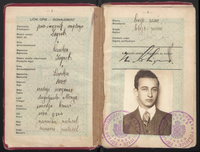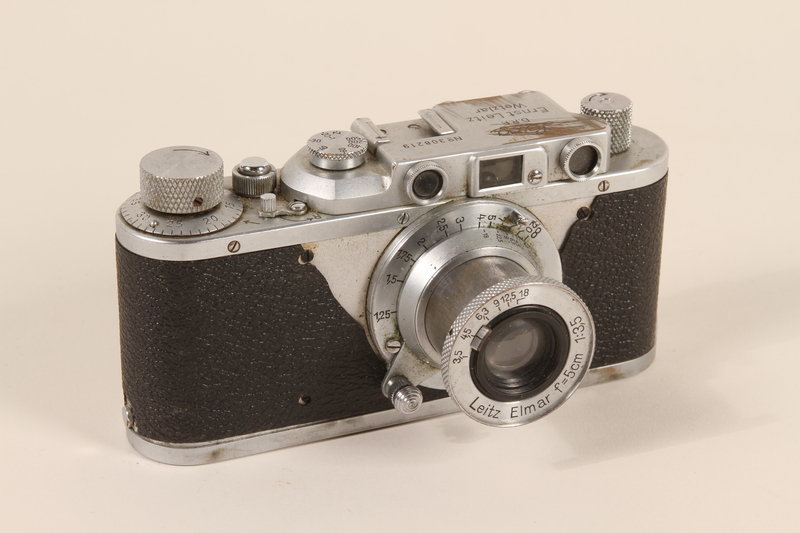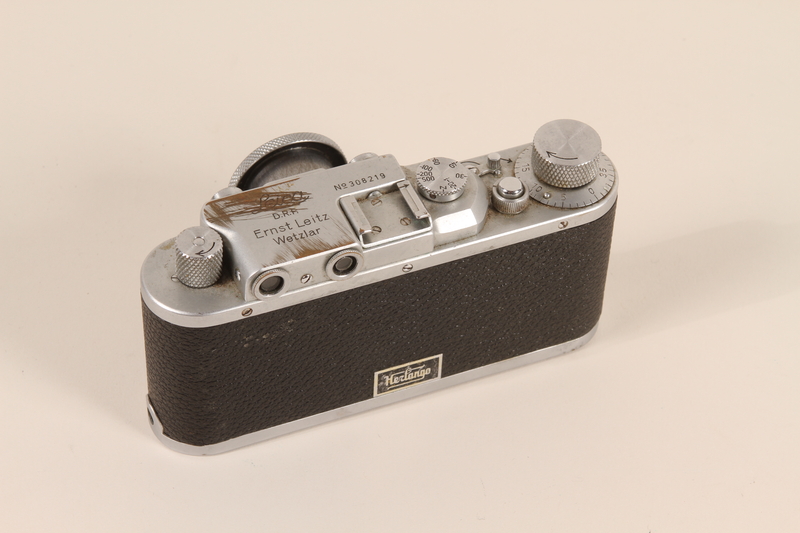Overview
- Brief Narrative
- Chrome Leica 35mm camera used by Ivo Herlinger while he was living in hiding in Italy from 1941-1944. After Nazi Germany invaded Yugoslavia in June 1941, Ivo and his wife, Elsa, fled Zagreb to avoid internment in a German labor camp. They had to leave their 2 year old daughter, Lea, with an aunt. A few months later, using jewels they had sewn into the lining of their clothes, they paid a student to bring Lea to them in Trieste, Italy. The family spent the next three years hiding under false identities in Rome and other towns in Italy, where Ivo used his camera to document their daily life. When the family emigrated to the United States in October 1950, US customs officials purposely scratched the top of the camera to prevent resale.
- Date
-
use:
1940-1950
manufacture: 1938 January-1938 February
- Geography
-
use:
Rome (Italy)
manufacture: Wetzlar (Germany)
- Credit Line
- United States Holocaust Memorial Museum Collection, Gift of Allan and Lea Kaluzna
- Markings
- top of view finder, engraved : Leica / No. 308219 / D.R.P. / Ernst Leitz / Wetzlar
printed on lens : Leitz Elmar f= 5cm 1:35 ( and other numbers on the lens)
back, metal tag, stamped : Herlango
bottom, stamped : AUF / ZU - Contributor
-
Subject:
Ivo Herlinger
Subject: Lea Kaluzna
Manufacturer: Ernst Leitz
- Biography
-
Ivek (Ivo) Herlinger was born on August 18, 1902. He and his wife, Elsa, lived in Zagreb, Yugoslavia (Croatia). Ivo worked as a representative for Remington Office Machines. Elsa worked as a legal secretary until the birth of their daughter, Lea, on December 13, 1938. In 1941, Germany invaded Yugoslavia and divided the country. An independent state of Croatia was declared, ruled by the Fascist Ustasa party. Around June 1941, the Herlinger’s were told to report to a labor camp. The family fled the city that evening. They sent Lea to an aunt, Zlata Herlinger, who lived on a farm in the countryside. Elsa went to stay with some non-Jewish friends, while Ivo searched for a place they could live together. He posed as an engineer’s call man on the railroad, and went to Trieste. After Elsa joined him there, they hired a student to bring Lea to Trieste, paying him with gems they had sewn into their clothing.
Once Lea arrived, the family went to Castel Guilemo, Italy. They remained there for the next 18 months, hiding in an attic above a store with 21 other people. Warned that the Germans were approaching, they fled again, this time to Rome. For the next year and a half, Elsa, Lea, and Aunt Zlata lived in a convent, and Ivo, and Zlata’s family, Arthur and Otto, lived in a monastery. They would reunite each Sunday in front of St. Peter’s Cathedral. During one of these Sunday meetings, as they were saying goodbye, Ivo waved to his daughter as a Croatian would, instead of an Italian. A pair of German officers spotted this, and chased him, but he managed to escape. They moved to an apartment and lived under false identities: Ivo as Giovanni Fabiani and Lea as Lena. Lea was able to attend the nearby convent school as she could walk there with her mother. Ivo stayed in the apartment during the day. Lea remembers that on one day, when she was home sick, her father insisted that they leave the apartment. After they left, the air raid sirens went off, and the family took cover in a doorway. When they returned to their apartment, they found that the building had been demolished by a bomb.
After liberation of Rome in June 1944, the family moved to a new apartment, and Lea began attending public school. They lived as stateless refugees, until they were allowed to emigrate to the United States. In October 1950, after a three-week journey on board the General Harry Taylor, the family arrived in New York. With assistance from the Hebrew Immigrant Aid Society (HIAS), they eventually settled in Chicago. Elsa died in 1991. Ivo passed away, age 93 years, on December 5, 1995.
Lea Herlinger was born on December 13, 1938, in Zagreb, Croatia (Yugoslavia) to Ivek (Ivo) (8/16/1902-12/5/1995) and Elsa Herlinger (d. 7/31/1991). Ivo worked as a representative for Remington Office Machines, while Elsa worked as a legal secretary until Lea was born. In 1941, Germany invaded Yugoslavia and divided the country. An independent state of Croatia was declared, ruled by the Fascist Ustasa party. Her parents were told to report to a labor camp, so that night, they fled the city. Lea was sent to her aunt Zlata Herlinger, who had a farm in the countryside. Elsa went to stay with some non-Jewish friends, while Ivo searched for a place they could live together He posed as an engineer’s call man on the railroad, and went to Trieste, where he and Elsa were soon reunited. They hired a student to being Lea to Trieste, paying him with precious stones they had sewn into their clothing. Once she arrived, the family went to Castel Guilemo, Italy. They remained there for the next 18 months, hiding in an attic above a store with 21 people; Lea was the only child. Warned that the Germans were approaching, they fled again, this time to Rome. For the next year and a half, Elsa, lea, and Aunt Zlata lived in a convent while Ivo and Zlata’s family, Arthur, and Otto, lived in a monastery. They would reunite each Sunday in front of St. Peter’s Cathedral. During one of these Sunday meetings, as they were saying goodbye, Ivo waved to his daughter as a Croatian would, instead of as an Italian. A pair of German officers spotted this, and chased him, but he managed to escape. They moved to an apartment in Rome and lived under false identities: Ivo as Giovanni Fabiani and Lea as Lena. She attended school at the convent, and walked there every day with her mother, careful not to speak to anyone. Ivo remained in the apartment during the day. Lena remembers that one day, when she was home sick, Ivo insisted that they leave the apartment. After they left, the air raid sirens went off, and the family took cover in a doorway. When they returned to their apartment, they found that the building had been demolished by a bomb. After liberation, the family moved to a new apartment, and Lea attended public school. They lived as stateless refugees in Italy, until they received visas to emigrate to the United States. In October 1950, after a three-week journey on board the General Harry Taylor, the family arrived in New York. With assistance from the Hebrew Immigrant Aid Society (HIAS), they eventually settled in Chicago.
Physical Details
- Language
- German
- Classification
-
Audiovisual and Photographic Materials
- Category
-
Cameras
- Object Type
-
Leica camera (lcsh)
- Physical Description
- Small, rectangular chrome steel alloy camera, encased in black, textured plastic. Attached to the front of the camera is a circular adjustable lens with a finger knob. The lens has a glass center set in threaded black plastic, surrounded with metal. There are numbers on 3 sides of the lens casing. Above the lens are 2 glass viewfinders and 1 glass for the flash. The top has a winder dial on the left, then a dock for a flash, a film speed dial, the shutter, the film advancer, and a re-winder lock. Attached to the back are 2 viewfinders and, at the bottom center, a square metal tag. The bottom has a threaded catch for a tripod and the re-winder handle with 2 arrows and text.
- Dimensions
- overall: Height: 2.750 inches (6.985 cm) | Width: 5.125 inches (13.018 cm) | Depth: 1.750 inches (4.445 cm)
- Materials
- overall : chrome steel, metal, glass, plastic, paint
Rights & Restrictions
- Conditions on Access
- No restrictions on access
- Conditions on Use
- No restrictions on use
Keywords & Subjects
- Topical Term
- Hidden children (Holocaust)--Italy--Biography. Holocaust, Jewish (1939-1945)--Croatia--Zagreb--Personal narratives. Holocaust, Jewish (1939-1945)--Italy--Personal narratives. Jewish children in the Holocaust--Italy--Biography. Jewish refugees--Italy--Biography. World War, 1939-1945--Refugees--Italy--Personal narratives.
Administrative Notes
- Legal Status
- Permanent Collection
- Provenance
- The camera was donated to the United States Holocaust Memorial Museum in 2005 by Allan and Lea Kaluzna, the son-in-law and daughter of Elsa and Ivo Herlinger.
- Record last modified:
- 2023-03-17 11:50:06
- This page:
- https://collections.ushmm.org/search/catalog/irn517350
Also in Lea Herlinger Kaluzna family collection
The collection consists of a Leica camera, documents, and photographs relating to the experiences of Elsa, Ivo, and Lea Herlinger before the Holocaust in Yugoslavia, during and after the Holocaust in Italy, including the years they lived in hiding, and after their 1950 emigration to the United States.
Date: 1923-1950

Herlinger family papers
Document
The Herlinger family papers consist primarily of identification documents for Ivo and Elsa Herlinger, who lived as refugees from the Nazis in Italy during World War II, and later immigrated to the United States. The majority of the documents are items such as identification cards, passports, a birth certificate, and a marriage certificate. Other items of identification include verification of employment for Ivo, and his declaration of intent to the United States. The Herlinger family papers consist primarily of identification documents for Ivo and Elsa Herlinger, who lived as refugees from the Nazis in Italy during World War II, and later immigrated to the United States. The majority of the documents are items such as identification cards, passports, a birth certificates, and a marriage certificate. Other items of identification include records needed for immigration to the United States, such as a verification of employment for Ivo, and his declaration of intent. The naturalization papers of both Elsa and Ivo are in this collection. Also included are photographs of the Herlinger family, some correspondence regarding taxes to a cemetery in Zagreb, and identification papers for a Xene West, whose relation could not be identified.





